This month the two of us are actually in the same place at the same time, and we’re having a conversation about square pegs.
We are all not just square pegs and round pegs. We are triangles, pentagons, hexagon, oval, rhomboids, stars. There are shapes for everyone and places, too, where each of us fits best. But we all know what being a square peg means.
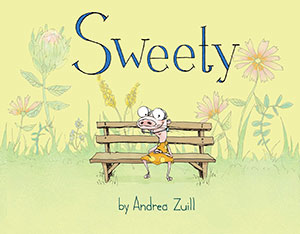 Sweety in the book Sweety by Andrea Zuill didn’t know, though, exactly what it meant when her grandmother said, “Well, aren’t you Grandma’s little square peg?” Young readers might not know either, but we do learn that Sweety is awkward and doesn’t always fit in, can be intense, and has bizarre hobbies like studying mushrooms.
Sweety in the book Sweety by Andrea Zuill didn’t know, though, exactly what it meant when her grandmother said, “Well, aren’t you Grandma’s little square peg?” Young readers might not know either, but we do learn that Sweety is awkward and doesn’t always fit in, can be intense, and has bizarre hobbies like studying mushrooms.
Jackie: Zuill tackles the subject with humor and compassion. She begins with humor in a parenthetical note. “(Please note that naked mole rats are born without fur but not without the love of clothes. The illustrator is grateful for this since she didn’t have to draw a bunch of highly embarrassing pictures.)” I couldn’t help but laugh when I saw Sweety describe her doll: “Friend of the friendless, destroyer of evil, lover of chocolate beet cake with cream cheese frosting!”
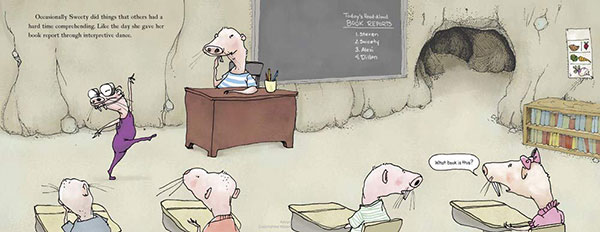
Phyllis: And she does it in an extremely loud voice, astonishing her classmates. Compassion comes to Sweety in the form of her Aunt Ruth, who talks about how she was called a square peg when she was young. She tells Sweety “that being different was one of the best things about her life, and that if you stayed true to yourself, you’d find your people.”
Jackie: And by the end of the book Sweety does. This is so much more than a “message” book. It’s so much fun, and we are as happy as Sweety when her “people” appear in the form of a mushroom-loving, caterpillar-loving naked mole rat named Sandy.
Phyllis: There’s even a secret handshake.
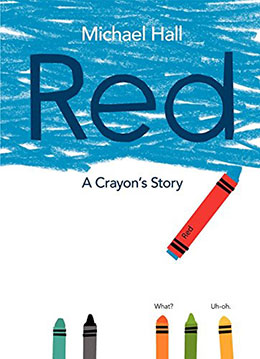 Jackie: Red A Crayon’s Story by Michael Hall is not just a crayon’s story. It is a story of wearing a label that doesn’t match who you are; Red’s wrapper says he’s red, but everything he colors comes out blue, and readers can see that he’s really a blue crayon. The crayons around him can only see his wrapper.
Jackie: Red A Crayon’s Story by Michael Hall is not just a crayon’s story. It is a story of wearing a label that doesn’t match who you are; Red’s wrapper says he’s red, but everything he colors comes out blue, and readers can see that he’s really a blue crayon. The crayons around him can only see his wrapper.
Phyllis: The other crayons try to fix him. “He’s got to press harder.” “He’s got to apply himself.” But everything he colors keeps coming out blue — blue strawberries, blue bugs, blue hearts, blue foxes, blue streetlights. Eventually with the help of a new berry-colored crayon friend, Red comes out, too. He discovers that he’s not lazy, not really “not bright” as the other crayons speculated. He is just really blue.
Jackie: And once he finds his true color, the other crayons are glad for him, and one even says, “I always said he was blue.” They want to do projects with him and celebrate, as we do, when he reaches for the sky. This is an understated story, and the illustrations, which appear understated, too, are so effective.
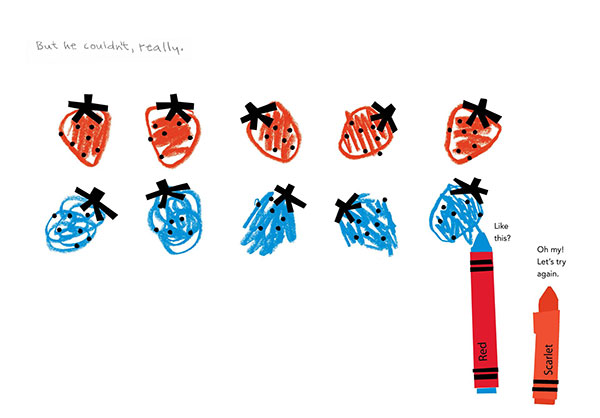
Phyllis: This book makes us both so happy and even makes us want to reach for a box of crayons.
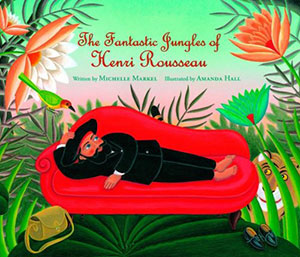 Phyllis: The Fantastic Jungles of Henri Rousseau by Michelle Markel, illustrated by Amanda Hall, begins with a man who doesn’t fit. He is a forty-year-old toll collector who wants to be an artist. “Not a single person has ever told him he is talented,” but he paints anyway because he loves nature and teaches himself technique by going to the Louvre and examining “the satiny paintings of his favorite artists.”
Phyllis: The Fantastic Jungles of Henri Rousseau by Michelle Markel, illustrated by Amanda Hall, begins with a man who doesn’t fit. He is a forty-year-old toll collector who wants to be an artist. “Not a single person has ever told him he is talented,” but he paints anyway because he loves nature and teaches himself technique by going to the Louvre and examining “the satiny paintings of his favorite artists.”
Jackie: One day he puts his canvases in a handcart and wheels them to an exhibition. It does not go well. Experts say mean things. He keeps painting — pictures of plants and animals from far away places. “Sometimes Henri is so startled by what he paints that he has to open the window to let in some air.” And even though every year he takes his paintings to the exhibit, the experts continue to make fun of him. “They say it looks like he closed his eyes and painted with his feet.”
Phyllis: He keeps painting. “He spends all he earns on art supplies and pays for his bread and coal with landscapes and portraits.” No matter what the experts say, “every morning he wakes up and smiles at his pictures.” Finally, when he is sixty-one, other artists disagree with the experts, befriending Henri and coming to concerts in his studio. Picasso throws a banquet for him. And when Henri exhibits his painting “The Dream,” few people make fun of him.
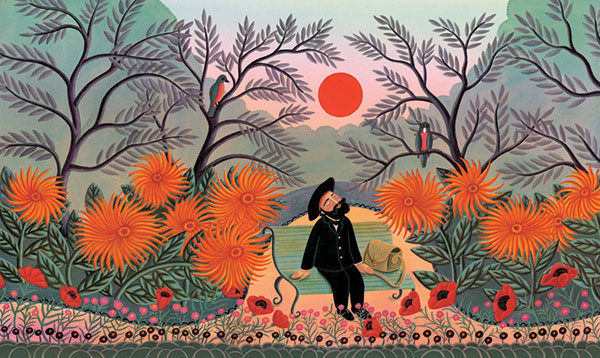
Jackie: The illustrator made a special trip to Paris before illustrating this book, and it shows. Her paintings capture the wild spirit of Rousseau’s work while still being uniquely her own. In this book, Rousseau started out as a square peg, and his talent reshaped the world.
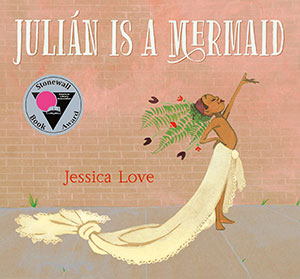
Phyllis: Julián is a Mermaid by Jessica Love is a book about a boy named Julián who loves mermaids and about his abuela. Julián sees people dressed as mermaids on a train, and he dreams (in gorgeous art) that he is a mermaid, too, complete with tail. In his dream a benevolent fish gives him beads. On the way home Julián tells his abuela he is a mermaid, too. While she takes a bath he has an idea.
Jackie: With a fern and flowers for hair and a curtain for a tail, Julián transforms himself. The book’s crisis occurs when his abuela comes out of the bath, sees him, frowns, and walks away. Uh-oh, says Julián. A worried Julián looks again at his long beautiful tail. He looks in a mirror at his ferny and flowery hair. Has he done something wrong? Then his grandmother returns. “Come here, mijo,” she says right before a page turn — which we turn quickly. She gives him beads.
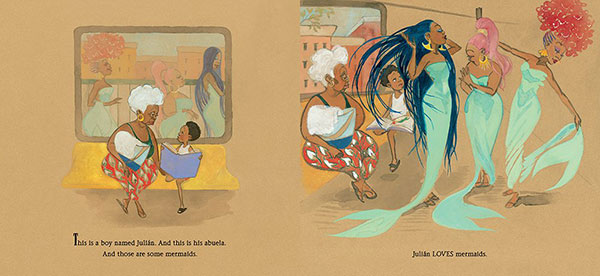
Phyllis: A smiling mermaid Julián and his abuela head out for a walk. “Where are we going?” asks Julián. “You’ll see,” says Abuela. One more page turn shows us Julián and Abuela at the mermaid parade on Coney Island. And like Sweety, Julián has found his people.
Jackie and Phyllis: Round pegs, square pegs, pegs of every shape — may we all, like Sweety and Henri and Red and Julián, find our people.

Thank goodness we are all so many different shapes!